Computerized Cognitive Training
Generally what we mean by ‘brain training’ is computerized cognitive training (CCT) – apps usually designed to improve your attention, processing speed, memory, reasoning and so on.
Here I shall be reviewing what is known about the effectiveness of this kind of training for cognitive performance.
Cognitive Performance
Cognitive performance is defined as competence and effectiveness in meeting a mental challenge.
Examples include
- doing well in an entrance exam or job test
- solving a problem at work
- making a sound decision that has wide impact
- devising an effective career strategy
- learning a new skill efficiently
- retaining self-control under pressure
- coming up with a creative entrepreneurial idea
The current economy is based in large part on cognitive performance – what has been called ‘cognitive capital’ or ‘mental capital’.
General Intelligence (G)
The most general idea of cognitive performance is that of general intelligence, sometimes simply called ‘G’. General intelligence has been defined in different ways by different scientists. An excellent compilation of definitions of general intelligence can be found here. Here are two of the better definitions by scientists in the field:
“Intelligence is a very general mental capability that involves the ability to reason, plan, solve problems, think abstractly, comprehend complex ideas, learn quickly and learn from experience.” L. S. Gottfredson
“Intelligence is the ability to solve problems, or to create products, that are valued within one or more cultural settings.” H. Gardner
IQ Tests
The most well-known measure of general intelligence is a standardized IQ test. ‘IQ’ stands for ‘intelligence quotient’. Standardized means that scores can be compared in the general population and you know what score is needed to be in a certain percentile – for instance above average, or in the top 2% (Mensa standard). Examples of IQ tests include the Wechsler Adult Intelligence Scale, the Stanford-Binet, and the Cattell Culture Fair test, and Raven’s Progressive Matrices.
There are many bogus IQ tests on the web that either don’t accurately or reliably measure your general intelligence, or which give you an inflated score. Valid, reliable, standardized tests are difficult to locate and are usually professionally administered.
IQ tests certainly aren’t designed to measure everything important about cognitive performance. They do not measure decision-making ability, attention control, self-control or creativity for instance. But IQ tests are the best tests for cognitive performance that scientists have devised. IQ test scores can be used to predict achievements in a wide range of abilities, including creativity, educational attainment, health, leadership, lifespan, professional achievement and income. IQ tests are widely used in our institutions and organisations because of their consistency and validity. Schools and universities use IQ tests (or ‘aptitude tests’) to select and stream students, companies use IQ tests to screen applicants, with estimates of 80% of Fortune 500 companies’ HR departments using these kinds of tests for recruitment.
IQ tests are designed so that the average IQ score for test takers is 100. IQ test scores have a distribution in the general population that looks like a symmetrical bell – which is why the IQ distribution is often called a ‘bell curve’. You can see this ‘bell’ in the figure below:

By looking at areas of this curve, you can see that the majority of people (68%) have an IQ score between 85 and 115. Only around 2% have an IQ greater than 130 which is often called ‘gifted’ intelligence. This is the IQ score needed to join Mensa.
Here is a table that helps us interpret what IQ scores within certain ranges mean:
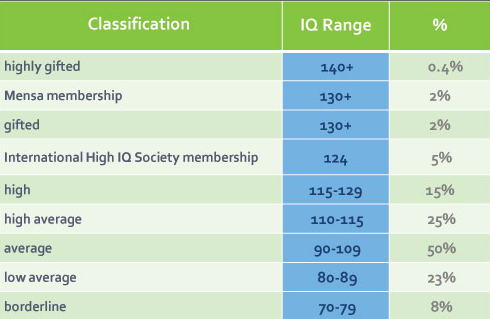
For a rough guide, an IQ of 115 or higher can be considered a ‘high IQ’. Generally speaking, this equips someone to take on a university degree. An IQ of 130 or higher puts a person into the ‘IQ elite’ – the sphere of Harvard undergraduates and grad students.
Is Intelligence ‘Fixed In Stone’?
What determines our intelligence level and can it be improved? Individual differences in intelligence – as measured by IQ tests – are determined by a combination of environmental factors and genetics. Environmental factors include a mother’s health during pregnancy, stressors from the physical environment, nutrition, general health and hygiene, education, cultural and social stimulation, and some types of brain training. Genetics is our genome – the genetic material we are born with encoded in our DNA. Environmental inputs in the [environment + genetics > IQ] equation are clearly not fixed in stone. And while our DNA cannot be modified to improve our IQ, how our DNA is expressed at a cellular level can be modified by the right interventions – including nutrition, fasting and exercise as we shall see.
Identical twins separated at birth and raised in different family, educational and cultural environments will have correlated IQ test scores due to the shared genetics. Taking into account a range of cultural environments, the genetic contribution to IQ differences has been estimated to be close to 50%.
The ‘Flynn Effect’ is one demonstration of the impact of environmental factors on IQ. Throughout the last decades of the 20th Century, IQ test performance has risen substantially – typically about 3–5 IQ points per decade.
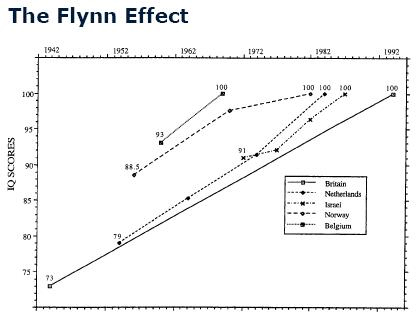
This data suggests that if you gave a modern IQ test to your grandparent’s generation their average score would have been around 80, not 100. Some evidence suggests this steady rise in IQ may have peaked in the late 1990s, with a moderate decline since then.
The Flynn Effect is a well-known demonstration of why IQ levels are not ‘fixed in stone’. We have seen a period of several decades where environments were such that whole populations got smarter.
Increasing IQ with Computerized Cognitive Training: Working Memory Training
Over the past 10 years there has been a growing body of scientific evidence that a specific type of computerized cognitive training (CCT) has the potential to raise IQ significantly – namely working memory training. Commercial CCT comes in many forms. Many brain training companies divide training between different types of cognitive processing such as speed, memory, attention, and so on. But working memory training that has the strongest evidential support for increasing general intelligence.
What is working memory?
Working memory is our ‘mental workspace’. Imagine your mind as a white board that is constantly being written on, while you organize and do calculations with the material before erasing it as you shift your focus from one task to the next – that is your working memory system.
More formally, working memory is a short term memory and management system that
“provides temporary storage and manipulation of the information necessary for such complex cognitive tasks as language comprehension, learning, and reasoning.” (Baddeley, 2003, p. 189)
Individuals differ in their working memory capacity – i.e. the quantity of information they can maintain and process. Working memory capacity correlates highly with IQ as well as educational outcomes.
This makes sense, as you can imagine that more intelligent people have a larger mental ‘workspace’ and are able to make relatively more connections and inferences using their spacious workspace.
Dual N-Back Training
 In 2008 Susanne M. Jaeggi and colleagues published a seminal paper showing the wide transfer of 20 days of computerized working memory training to intelligence. ‘Wide transfer’ means that training does not simply result in improvements on the game itself but improves performance on general cognitive ability and IQ tests. This paper generated a tremendous amount of interest in the potential of brain training to improve intelligence.
In 2008 Susanne M. Jaeggi and colleagues published a seminal paper showing the wide transfer of 20 days of computerized working memory training to intelligence. ‘Wide transfer’ means that training does not simply result in improvements on the game itself but improves performance on general cognitive ability and IQ tests. This paper generated a tremendous amount of interest in the potential of brain training to improve intelligence.
The working memory exercise Jaeggi used was the dual n-back – which is now the most widely studied computerized cognitive training game. It involves viewing a continuous stream of items such as moving squares and deciding whether each square location matches the location ‘n’ stimuli back in time. The memory ‘gap’ is the ‘n-back level’. If you need to keep track of the location 2 moves back, then you are at the 2-back level. If you are tracking the location 3 moves back – then you are at the 3-back level. Here you can see a 2-back example:
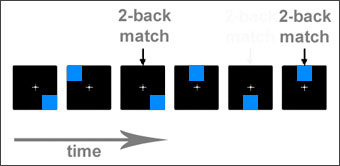
In dual n-back training, both a verbal and a visual stream of items are presented simultaneously as shown below for a 2-back game:
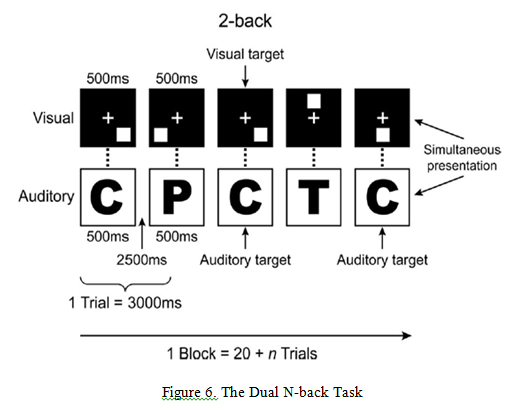
How Effective Is Dual N-Back Training?
N-back training-related improvements are wide-ranging, including non-trained working memory functions, executive functioning, and memory for events.
What about IQ gains?
Jaeggi and her colleagues published their dual n-back study back in 2008. Since then numerous studies investigating the effects of dual n-back training on general intelligence have been published, and there has been a heated controversy among both cognitive scientists and the popular media surrounding the idea that cognitive training can increase IQ.
Some studies have failed to replicate the IQ-boosting training effect – such as this study by a team led by Todd Thompson in MIT’s Department of Brain and Cognitive Sciences which concluded:
“[our] findings fail to support the idea that adaptive working memory training in healthy young adults enhances working memory capacity in non-trained tasks, fluid intelligence, or other measures of cognitive abilities.” (2013)
But numerous other studies find a significant IQ increasing effect, such as this one by Sarah Rudebeck in Oxford University’s Department of Experimental Psychology:
“we found that the trainers, compared to non-trainers, exhibited a significant improvement in fluid intelligence after 20 days…. Our findings demonstrate that practice on a …working memory task can potentially improve aspects of both ….memory and fluid intelligence.” (2012)
So how are we to evaluate the conflicting evidence? Does dual n-back training work or not?
In answering this question, we need to distinguish between different grades of evidence.
- ‘In house’ research conference talks, papers ‘under review’ and other non-published material. (e.g. Lumos Labs unpublished papers.)
- Single peer-reviewed journal articles that have not been replicated.
- Several peer-reviewed journal articles from different labs with replications.
- Meta-reviews of multiple peer-reviewed journal articles with replications.
The higher the level the more reliable the evidence.
The latest meta-review of working memory training concludes, that yes, dual n-back training is effective in improving general cognitive ability and IQ test scores.
The 2014 paper by Jacky Au and colleagues at the University of California, concludes:
“Our work demonstrates the efficacy of several weeks of n-back training in improving performance on measures of Gf [fluid intelligence]. We urge that future studies move beyond attempts to answer the simple question of whether or not there is transfer and, instead, seek to explore the nature and extent of how these improved test scores can translate into practical, real-world settings.”
Based on this meta-review evidence – the highest grade scientific evidence we have – we can conclude that dual n-back training is worth investing your time and effort into if you want to achieve gains in general cognitive performance. No equivalent gains result from other types of computerized cognitive training.
Increasing IQ Gains: Dual N-Back Optimization
Jacky Au and colleagues argue in their meta-review that the average increase in IQ from training they found is an under-estimate due to the samples and testing criteria. Moreover, they believe that the effect size they reported could be increased by optimizing certain game parameters including:
- Program completion
- Increasing intrinsic motivation for program completion
For these reasons the authors argue:
“the results reported in this meta-analysis represent a low-end estimate of the true extent of improvement that n-back training can have on measures of [intelligence]”.
At IQ Mindware we focus on determining precisely what parameters of dual n-back training can optimize wide transfer to IQ and general cognitive health, resilience and performance.
Interference Control & ‘Second Generation’ Dual N-Back Training
One strong candidate parameter for optimizing dual n-back training is interference control.
Interference is a technical term for distracting information that is similar to the information you need to perform well in a game or cognitive challenge. If you are playing the n-back game, and you are at a 3-back level, a matching stimulus for N=2 or N=4 would qualify as interference. This is shown in the diagram.

Another example of interference is found in the ‘Stroop task’. You can try the task for yourself now – going from left to right, as quickly as you can say aloud the ink color of the words here – ignoring the word meaning (the answer for the first one is ‘red’).
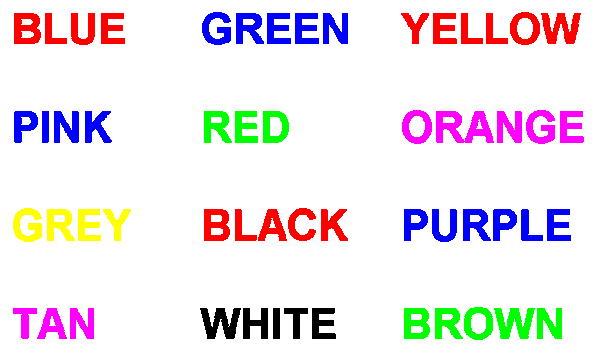
Because reading words is so well-practiced and automatic, there is a strong interference effect in this task – as you’ll have noticed! The meaning of the word captures your attention, and interferes with your ability to perform the task. It takes concentration to control this interference.
There is good scientific evidence that interference control – the ability to filter out distracting information of this sort – underlies the link between working memory and intelligence.
- Brain imaging studies reveal that neural mechanisms of interference control underlie the relationship between fluid intelligence and working memory span.
- Claudia von Bastiana and Klaus Oberauera at the Department of Psychology, University of Zurich, have found that a game based on ‘supervision’ working memory training alone resulted in IQ gains. Supervision is terminology for that aspect of working memory used for interference control – defined as “selective activation of relevant and inhibition of irrelevant information”.
We have concluded that interference control is critical in working memory training for IQ gains, and interference control is built into all the IQ Mindware apps as a default. Building interference control into the dual n-back game systematically is something new, and for this reason I call it ‘second generation’ (2G) dual n-back training.
Summary
When thinking about brain training for cognitive performance we can consider an analogy with sports performance.
Substantial gains in sports performance are now possible – and achieving those gains relies on scientifically guided training programs. Likewise it is becoming apparent that cognitive performance gains are possible and these too rely on scientifically guided training programs. Evolved versions of the dual n-back and other forms of working memory training will be central over the next decade in achieving and maintaining the highest levels of cognitive performance.